-
 Bitcoin
Bitcoin $83,309.8774
-1.88% -
 Ethereum
Ethereum $1,591.3660
-2.42% -
 Tether USDt
Tether USDt $0.9998
-0.01% -
 XRP
XRP $2.0864
-2.28% -
 BNB
BNB $580.9809
-0.68% -
 Solana
Solana $125.6682
-3.01% -
 USDC
USDC $0.9999
0.00% -
 TRON
TRON $0.2516
0.03% -
 Dogecoin
Dogecoin $0.1542
-3.08% -
 Cardano
Cardano $0.6142
-3.69% -
 UNUS SED LEO
UNUS SED LEO $9.3431
-0.92% -
 Chainlink
Chainlink $12.3641
-2.37% -
 Avalanche
Avalanche $18.8865
-5.31% -
 Stellar
Stellar $0.2358
-2.40% -
 Toncoin
Toncoin $2.8805
-0.91% -
 Shiba Inu
Shiba Inu $0.0...01169
-1.89% -
 Sui
Sui $2.1008
-4.00% -
 Hedera
Hedera $0.1574
-5.48% -
 Bitcoin Cash
Bitcoin Cash $318.9019
-1.04% -
 Litecoin
Litecoin $75.9077
-2.52% -
 Polkadot
Polkadot $3.5432
-3.69% -
 Dai
Dai $1.0000
0.00% -
 Bitget Token
Bitget Token $4.2538
-1.47% -
 Hyperliquid
Hyperliquid $15.1227
-5.40% -
 Ethena USDe
Ethena USDe $0.9991
0.00% -
 Pi
Pi $0.6199
-16.77% -
 Monero
Monero $217.3319
2.19% -
 Uniswap
Uniswap $5.2227
-2.58% -
 OKB
OKB $52.2436
1.28% -
 Pepe
Pepe $0.0...07082
-3.62%
What is Bulletproofs on a blockchain?
Bulletproofs enhance blockchain privacy and efficiency by enabling confidential transactions without revealing amounts, significantly reducing transaction sizes and improving scalability.
Apr 13, 2025 at 09:07 am

Bulletproofs are a type of zero-knowledge proof that plays a crucial role in enhancing privacy and efficiency on blockchains. In the world of cryptocurrencies, where transparency and privacy often collide, Bulletproofs offer a solution that allows for confidential transactions without compromising the integrity of the network. This article delves into the intricacies of Bulletproofs, explaining their functionality, implementation, and significance within the blockchain ecosystem.
Understanding Zero-Knowledge Proofs
Zero-knowledge proofs (ZKPs) are cryptographic protocols that allow one party to prove to another that a statement is true, without revealing any information beyond the validity of the statement itself. In the context of blockchains, ZKPs are used to verify transactions without disclosing the actual amounts being transferred. This means that users can prove they have the necessary funds for a transaction without revealing their entire balance.
Bulletproofs are a specific type of ZKP that are particularly efficient and do not require a trusted setup. Unlike other zero-knowledge proofs, such as zk-SNARKs, Bulletproofs do not rely on a common reference string that must be generated in a trusted environment. This makes Bulletproofs more accessible and easier to implement on various blockchain platforms.
How Bulletproofs Work
Bulletproofs operate by proving that a committed value lies within a certain range without revealing the actual value. This is particularly useful for cryptocurrencies, as it allows for the verification of transaction amounts without disclosing them. The process involves generating a proof that demonstrates the transaction amount is within an acceptable range, ensuring that no negative amounts or excessive values are being transferred.
To understand how Bulletproofs work, consider the following steps:
- Commitment Scheme: The sender creates a commitment to the transaction amount using a cryptographic function. This commitment is a way to "lock" the value without revealing it.
- Range Proof: The sender then generates a Bulletproof, which is a proof that the committed value is within a specified range. This proof is attached to the transaction.
- Verification: The receiver or any node on the network can verify the Bulletproof without learning the actual transaction amount. If the proof is valid, the transaction is accepted; otherwise, it is rejected.
Implementation of Bulletproofs in Cryptocurrencies
Bulletproofs have been implemented in several cryptocurrencies, with one of the most notable being Monero (XMR). Monero, known for its focus on privacy, adopted Bulletproofs in 2018 to improve transaction efficiency and reduce transaction sizes. Before Bulletproofs, Monero used a different type of range proof called Ring Confidential Transactions (RingCT), which were larger and less efficient.
The implementation of Bulletproofs in Monero significantly reduced the size of transactions, making them faster to process and less costly in terms of network resources. This improvement was crucial for maintaining the scalability and usability of the Monero network.
Other cryptocurrencies and blockchain platforms have also explored the use of Bulletproofs. For instance, Bitcoin's sidechain, Liquid, uses Bulletproofs to enable confidential transactions. These implementations demonstrate the versatility and effectiveness of Bulletproofs in enhancing privacy across different blockchain ecosystems.
Benefits of Bulletproofs
The adoption of Bulletproofs brings several benefits to blockchain networks, particularly in terms of privacy and efficiency. Some of the key advantages include:
- Enhanced Privacy: Bulletproofs allow for the verification of transaction amounts without revealing them, ensuring that users' financial details remain confidential.
- Reduced Transaction Sizes: By using Bulletproofs, the size of transactions can be significantly reduced, leading to faster processing times and lower fees.
- Improved Scalability: The efficiency of Bulletproofs helps in scaling blockchain networks, as they can handle more transactions without a proportional increase in resource consumption.
- No Trusted Setup Required: Unlike some other zero-knowledge proofs, Bulletproofs do not require a trusted setup, making them more secure and easier to implement.
Challenges and Considerations
While Bulletproofs offer numerous advantages, there are also challenges and considerations to keep in mind. One of the primary challenges is the complexity of the cryptographic algorithms involved. Implementing and maintaining Bulletproofs requires a deep understanding of advanced cryptography, which can be a barrier for some developers and blockchain projects.
Additionally, the adoption of Bulletproofs may face resistance from regulatory bodies concerned about the potential for increased anonymity in financial transactions. Balancing privacy with regulatory compliance is a delicate issue that must be addressed carefully by blockchain projects using Bulletproofs.
Practical Applications of Bulletproofs
Bulletproofs have practical applications beyond just cryptocurrencies. They can be used in any scenario where confidential data needs to be verified without being revealed. For example, in supply chain management, Bulletproofs can be used to verify the authenticity of goods without disclosing sensitive information about the supply chain.
In voting systems, Bulletproofs can ensure the integrity of the vote without compromising voter anonymity. These applications highlight the versatility of Bulletproofs in solving real-world problems that require both privacy and verification.
Technical Details of Bulletproofs
To delve deeper into the technical aspects of Bulletproofs, it's essential to understand the underlying mathematics and algorithms. Bulletproofs are based on the concept of homomorphic commitments and the use of elliptic curves. The proof itself is constructed using a series of polynomial equations that are efficiently verifiable.
The key to Bulletproofs' efficiency lies in their logarithmic size, which means that the proof size grows logarithmically with the range being proven. This is a significant improvement over linear-sized proofs, making Bulletproofs more scalable for large-scale applications.
Bulletproofs in Action: A Case Study
To illustrate how Bulletproofs work in practice, let's consider a case study of Monero's implementation. Before Bulletproofs, Monero transactions were significantly larger due to the use of RingCT. The transition to Bulletproofs involved several steps:
- Research and Development: Monero's developers conducted extensive research to ensure that Bulletproofs would meet the network's needs.
- Testing: The new proof system was rigorously tested on a testnet to identify and resolve any potential issues.
- Implementation: Once tested, Bulletproofs were integrated into Monero's codebase, replacing the older RingCT system.
- Deployment: The updated Monero network went live with Bulletproofs, immediately reducing transaction sizes and improving network efficiency.
This case study demonstrates the practical steps involved in transitioning a blockchain network to use Bulletproofs and the tangible benefits that result from such a change.
Frequently Asked Questions
Q: Are Bulletproofs used in all cryptocurrencies?
A: No, Bulletproofs are not used in all cryptocurrencies. They are primarily implemented in privacy-focused cryptocurrencies like Monero and some Bitcoin sidechains like Liquid. Other cryptocurrencies may use different types of zero-knowledge proofs or not use them at all.
Q: Can Bulletproofs be used for purposes other than financial transactions?
A: Yes, Bulletproofs can be applied to various scenarios beyond financial transactions. They can be used in supply chain management to verify the authenticity of goods, in voting systems to ensure the integrity of votes, and in any other context where confidential data needs to be verified without being revealed.
Q: How do Bulletproofs affect the scalability of a blockchain?
A: Bulletproofs positively affect the scalability of a blockchain by reducing the size of transactions. This reduction leads to faster processing times and lower fees, allowing the network to handle more transactions efficiently.
Q: Are there any security concerns with using Bulletproofs?
A: While Bulletproofs are designed to be secure, the complexity of the underlying cryptography can pose challenges. Ensuring the correct implementation and ongoing maintenance of Bulletproofs requires expertise in advanced cryptographic techniques. Additionally, the increased privacy they provide may raise concerns from regulatory bodies.
Disclaimer:info@kdj.com
The information provided is not trading advice. kdj.com does not assume any responsibility for any investments made based on the information provided in this article. Cryptocurrencies are highly volatile and it is highly recommended that you invest with caution after thorough research!
If you believe that the content used on this website infringes your copyright, please contact us immediately (info@kdj.com) and we will delete it promptly.
- Movement Labs and the Movement Network Foundation have launched an independent investigation into recent market-making irregularities related to the MOVE token.
- 2025-04-16 09:15:12
- Shiba Inu (SHIB) burn rate saw an over 2000% hike, leading to the removal of 20.83 million tokens from circulation.
- 2025-04-16 09:15:12
- Securitize Acquires MG Stover's Fund Administration Business to Become the Largest Digital Asset Fund Administrator
- 2025-04-16 09:10:12
- Trump administration plans to present Congress with cuts to most funding for public media
- 2025-04-16 09:10:12
- XRP (XRP) Displays Promising Growth Potential as It Currently Trades Above $2.00 and the 21-week EMA
- 2025-04-16 09:05:13
- BYDFi Lists $KERNEL, the Governance Token of KernelDAO, with Spot Trading Now Live
- 2025-04-16 09:05:13
Related knowledge

Can the application of blockchain in supply chain finance bring benefits?
Apr 15,2025 at 04:00pm
Can the application of blockchain in supply chain finance bring benefits? The integration of blockchain technology into supply chain finance has garnered significant attention in the cryptocurrency and financial sectors. This article explores how blockchain can potentially revolutionize supply chain finance, detailing its benefits and providing a compre...
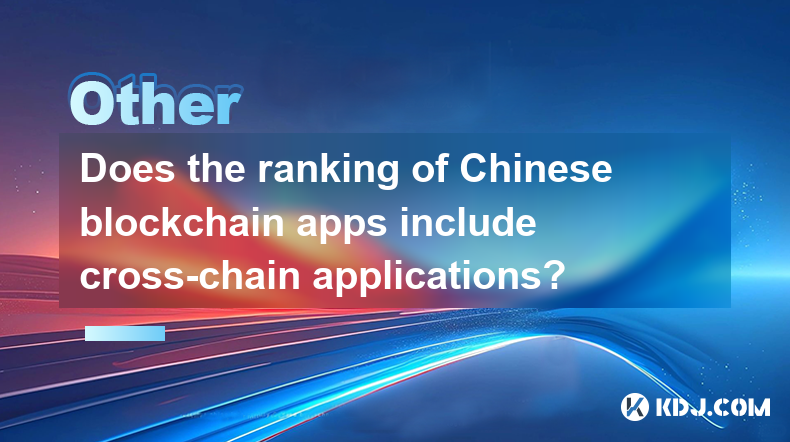
Does the ranking of Chinese blockchain apps include cross-chain applications?
Apr 14,2025 at 04:00pm
The ranking of Chinese blockchain apps is a comprehensive evaluation that takes into account various aspects such as user base, transaction volume, and technological innovation. A pertinent question arises regarding whether these rankings include cross-chain applications. Cross-chain applications, which allow different blockchain networks to interact an...
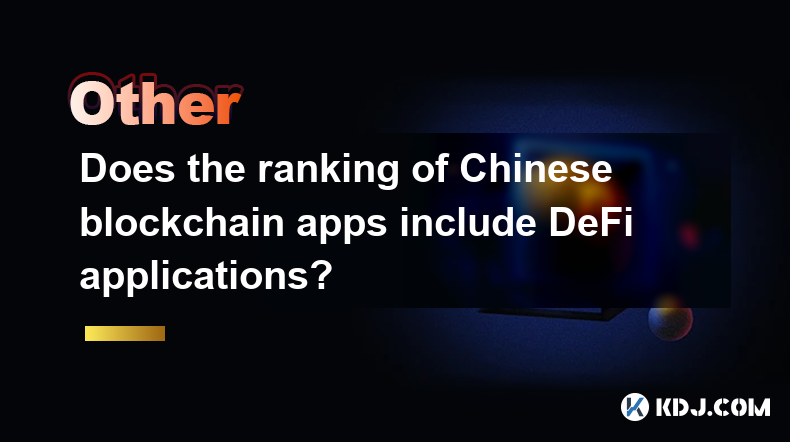
Does the ranking of Chinese blockchain apps include DeFi applications?
Apr 15,2025 at 06:57am
The ranking of Chinese blockchain apps is a comprehensive list that showcases the most popular and influential applications within the cryptocurrency ecosystem. One question that often arises is whether these rankings include DeFi applications. To answer this, we need to delve into the specifics of how these rankings are compiled and what types of appli...
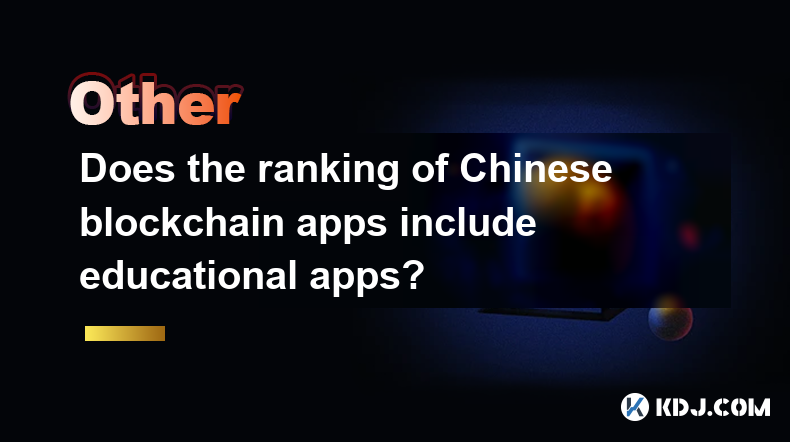
Does the ranking of Chinese blockchain apps include educational apps?
Apr 16,2025 at 03:35am
The ranking of Chinese blockchain apps often includes a variety of categories, from finance and gaming to social networking and beyond. One question that frequently arises is whether these rankings include educational apps. To address this, we need to delve into the specifics of how blockchain apps are categorized and ranked in China, and whether educat...
Does the ranking of Chinese blockchain apps include enterprise-level applications?
Apr 15,2025 at 06:42am
The ranking of Chinese blockchain apps often includes a variety of applications, ranging from consumer-focused to enterprise-level solutions. Understanding the scope and criteria for these rankings is essential to determine if enterprise-level applications are included. This article delves into the specifics of how Chinese blockchain app rankings are co...
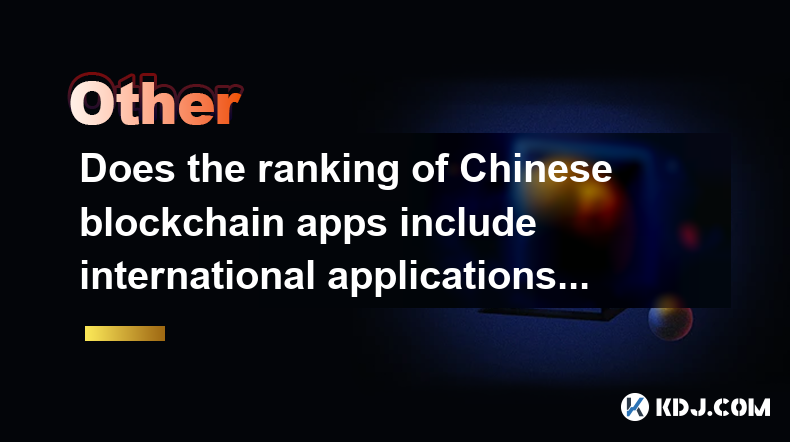
Does the ranking of Chinese blockchain apps include international applications?
Apr 16,2025 at 04:07am
The ranking of Chinese blockchain apps primarily focuses on applications developed and predominantly used within China. However, the question of whether these rankings include international applications is an intriguing one that warrants a detailed exploration. In this article, we will delve into the criteria used for ranking Chinese blockchain apps, th...

Can the application of blockchain in supply chain finance bring benefits?
Apr 15,2025 at 04:00pm
Can the application of blockchain in supply chain finance bring benefits? The integration of blockchain technology into supply chain finance has garnered significant attention in the cryptocurrency and financial sectors. This article explores how blockchain can potentially revolutionize supply chain finance, detailing its benefits and providing a compre...

Does the ranking of Chinese blockchain apps include cross-chain applications?
Apr 14,2025 at 04:00pm
The ranking of Chinese blockchain apps is a comprehensive evaluation that takes into account various aspects such as user base, transaction volume, and technological innovation. A pertinent question arises regarding whether these rankings include cross-chain applications. Cross-chain applications, which allow different blockchain networks to interact an...

Does the ranking of Chinese blockchain apps include DeFi applications?
Apr 15,2025 at 06:57am
The ranking of Chinese blockchain apps is a comprehensive list that showcases the most popular and influential applications within the cryptocurrency ecosystem. One question that often arises is whether these rankings include DeFi applications. To answer this, we need to delve into the specifics of how these rankings are compiled and what types of appli...

Does the ranking of Chinese blockchain apps include educational apps?
Apr 16,2025 at 03:35am
The ranking of Chinese blockchain apps often includes a variety of categories, from finance and gaming to social networking and beyond. One question that frequently arises is whether these rankings include educational apps. To address this, we need to delve into the specifics of how blockchain apps are categorized and ranked in China, and whether educat...

Does the ranking of Chinese blockchain apps include enterprise-level applications?
Apr 15,2025 at 06:42am
The ranking of Chinese blockchain apps often includes a variety of applications, ranging from consumer-focused to enterprise-level solutions. Understanding the scope and criteria for these rankings is essential to determine if enterprise-level applications are included. This article delves into the specifics of how Chinese blockchain app rankings are co...

Does the ranking of Chinese blockchain apps include international applications?
Apr 16,2025 at 04:07am
The ranking of Chinese blockchain apps primarily focuses on applications developed and predominantly used within China. However, the question of whether these rankings include international applications is an intriguing one that warrants a detailed exploration. In this article, we will delve into the criteria used for ranking Chinese blockchain apps, th...
See all articles























































































